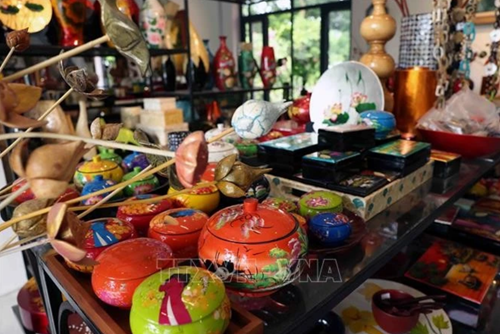March 30, 2025 | 22:21 (GMT+7)
Hanoi boosts economy through craft village development
A series of initiatives is being implemented to preserve and develop Hanoi’s craft villages, which has created tens of thousands of jobs across the capital.
According to statistics, Hanoi is home to more than 1,300 craft villages, representing 47 out of 52 traditional crafts nationwide. These villages produce a diverse range of goods, ranging from ceramics, weaving, embroidery, and lace-making, to fine woodworking and agricultural processing. Generating approximately 24 trillion VND (936.29 million USD) in annual revenue, they make a significant contribution to the city’s Gross Regional Domestic Product (GRDP).
    |
 |
|
Lacquerware products from Ha Thai lacquer craft village, located in Duyen Ha commune of Thuong Tin district, are exported to European markets, Japan, and the Republic of Korea. |
Recognizing the potential of its craft villages, Hanoi has incorporated measures for their conservation and development into the 2024 Capital Law. Additionally, the city has recently introduced a comprehensive plan for craft village development for the 2025-2030 period. By 2030, the capital aims to restore and preserve at least five endangered traditional crafts and villages, and officially recognize at least ten new crafts as well as 25 craft and traditional craft villages. Furthermore, it plans to invest in infrastructure and preserve the cultural spaces of these villages, integrating at least three craft villages with tourism and establishing ten craft village tourism routes.
Hanoi also aims to train at least 80% of workers in those villages, equipping them with improved vocational skills, workplace safety knowledge, and basic IT proficiency. The city targets having more than 50% of its craft villages recognized under the One Commune One Product (OCOP) program and supporting the digitalization of such products. Additionally, it targets an average annual production value growth of 10% for local craft villages and aims to have at least 30% of them featuring dedicated exhibition spaces, product showrooms, or online sales platforms.
Recently, Hanoi’s Bat Trang ceramic and Van Phuc silk villages officially joined the World Craft Cities Network. The membership presents significant opportunities for international cooperation, trade, and cultural promotion, strengthening the link between craft production and tourism while showcasing Hanoi’s rich cultural heritage to the world.
Source: VNA